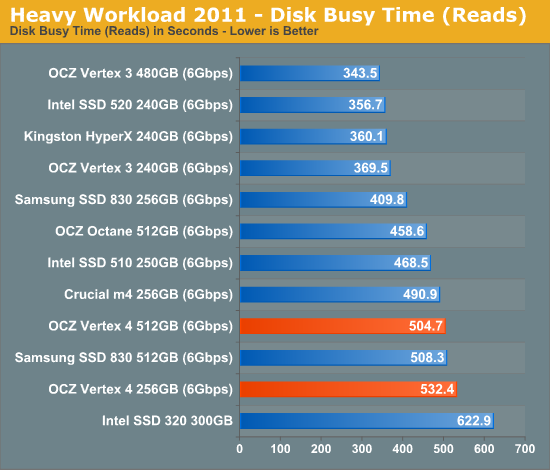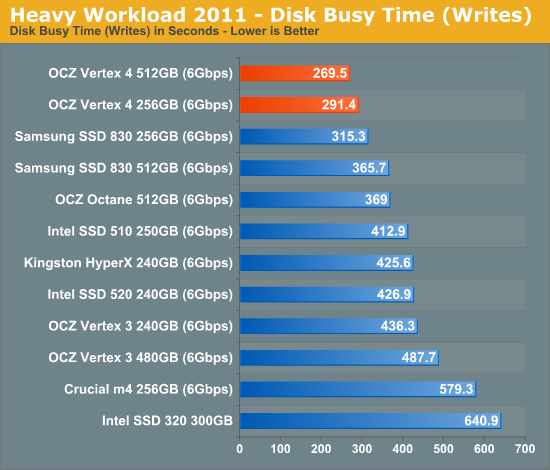OCZ Vertex 4 Review (256GB, 512GB)
by Anand Lal Shimpi on April 4, 2012 9:00 AM ESTAnandTech Storage Bench 2011
Two years ago we introduced our AnandTech Storage Bench, a suite of benchmarks that took traces of real OS/application usage and played them back in a repeatable manner. I assembled the traces myself out of frustration with the majority of what we have today in terms of SSD benchmarks.
Although the AnandTech Storage Bench tests did a good job of characterizing SSD performance, they weren't stressful enough. All of the tests performed less than 10GB of reads/writes and typically involved only 4GB of writes specifically. That's not even enough exceed the spare area on most SSDs. Most canned SSD benchmarks don't even come close to writing a single gigabyte of data, but that doesn't mean that simply writing 4GB is acceptable.
Originally I kept the benchmarks short enough that they wouldn't be a burden to run (~30 minutes) but long enough that they were representative of what a power user might do with their system.
Not too long ago I tweeted that I had created what I referred to as the Mother of All SSD Benchmarks (MOASB). Rather than only writing 4GB of data to the drive, this benchmark writes 106.32GB. It's the load you'd put on a drive after nearly two weeks of constant usage. And it takes a *long* time to run.
1) The MOASB, officially called AnandTech Storage Bench 2011 - Heavy Workload, mainly focuses on the times when your I/O activity is the highest. There is a lot of downloading and application installing that happens during the course of this test. My thinking was that it's during application installs, file copies, downloading and multitasking with all of this that you can really notice performance differences between drives.
2) I tried to cover as many bases as possible with the software I incorporated into this test. There's a lot of photo editing in Photoshop, HTML editing in Dreamweaver, web browsing, game playing/level loading (Starcraft II & WoW are both a part of the test) as well as general use stuff (application installing, virus scanning). I included a large amount of email downloading, document creation and editing as well. To top it all off I even use Visual Studio 2008 to build Chromium during the test.
The test has 2,168,893 read operations and 1,783,447 write operations. The IO breakdown is as follows:
| AnandTech Storage Bench 2011 - Heavy Workload IO Breakdown | ||||
| IO Size | % of Total | |||
| 4KB | 28% | |||
| 16KB | 10% | |||
| 32KB | 10% | |||
| 64KB | 4% | |||
Only 42% of all operations are sequential, the rest range from pseudo to fully random (with most falling in the pseudo-random category). Average queue depth is 4.625 IOs, with 59% of operations taking place in an IO queue of 1.
Many of you have asked for a better way to really characterize performance. Simply looking at IOPS doesn't really say much. As a result I'm going to be presenting Storage Bench 2011 data in a slightly different way. We'll have performance represented as Average MB/s, with higher numbers being better. At the same time I'll be reporting how long the SSD was busy while running this test. These disk busy graphs will show you exactly how much time was shaved off by using a faster drive vs. a slower one during the course of this test. Finally, I will also break out performance into reads, writes and combined. The reason I do this is to help balance out the fact that this test is unusually write intensive, which can often hide the benefits of a drive with good read performance.
There's also a new light workload for 2011. This is a far more reasonable, typical every day use case benchmark. Lots of web browsing, photo editing (but with a greater focus on photo consumption), video playback as well as some application installs and gaming. This test isn't nearly as write intensive as the MOASB but it's still multiple times more write intensive than what we were running in 2010.
As always I don't believe that these two benchmarks alone are enough to characterize the performance of a drive, but hopefully along with the rest of our tests they will help provide a better idea.
The testbed for Storage Bench 2011 has changed as well. We're now using a Sandy Bridge platform with full 6Gbps support for these tests.
AnandTech Storage Bench 2011 - Heavy Workload
We'll start out by looking at average data rate throughout our heavy workload test:
The overall score here is in-line with the SF-2281 solutions and OCZ's Octane. Our heavy workload is fairly write intensive, so I honestly expected the Vertex 4 to top the charts. Looking at the read/write breakdown explains why though:

Here we see the Vertex 4's poor low queue-depth sequential read performance rearing its head once more. Look at the sequential write speed and you'll see where OCZ makes up for its shortcomings however. The Vertex 4 writes quicker than any drive we've tested.

It's a tough tradeoff to come to terms with. The Vertex 4 delivers performance when it matters the most, but typically you want the absolute best performance regardless of workload. All of this may become moot if OCZ is able to address the situation with a firmware update in the coming weeks like it promised, but for buyers today it is something you have to think about.
The next three charts just represent the same data, but in a different manner. Instead of looking at average data rate, we're looking at how long the disk was busy for during this entire test. Note that disk busy time excludes any and all idles, this is just how long the SSD was busy doing something:














127 Comments
View All Comments
rw1986 - Friday, April 6, 2012 - link
This seems very speculative. OCZ has admitted collaboration with Marvell (for example on their new Kilimanjaro platform for the Z-Drive R5 PCIe SSD).here is the link to the OCZ Everest 2 announcement: http://www.ocztechnology.com/aboutocz/press/2012/4...
In the announcement, OCZ makes some specific claims surrounding Everest 2 -- for example:
"the Everest 2 SSD controller reduces latency to 0.043ms for read operations and 0.026ms for write operations, yielding an improvement of approximately 80 percent over the previous Everest SSD controller generation"
"The advanced, multi-level BCH ECC engine with progressive error correction adapts to the specific error characteristics of different NAND devices. The programmable ECC engine achieves an effective correction power of up to 128 bits per 1KB of data while significantly reducing the uncorrectable bit error rate (UBER)."
The Marvell sheet emphasizes some similar things (high performance, error correction technology) but these are more general claims than what OCZ has listed in their Everest 2 spec sheet.
Is the foundation of your assumption that Everest 2 is just the 88SS9187 that the spec sheets sound similar? That does not seem conclusive to put it generously
jwilliams4200 - Saturday, April 7, 2012 - link
There is no hard evidence that is publicly available since OCZ is keeping it quiet for obvious reasons.The Octane uses a rebadged Marvell 88SS9174, and the Vertex 4 uses a rebadged Marvell 88SS9187.
rw1986 - Saturday, April 7, 2012 - link
I'm just curious how you can make these claims so authoritatively when, as you say "there is no hard evidence that is publicly available" to support your position.What you seem to be suggesting is that OCZ made a 32 million dollar acquisition in April of 2011 (Indilinx) and then decided to simply license and rebadge controllers from Marvell rather than build internally (which is completely contrary to what OCZ has told investors and the public). On a Thursday conference call OCZ's CEO was quite adamant that Everest 2 is completely their IP and will improve their profit margin strucutre as a result (since they don't have to pay a fee to Sandforce for each controller as before). If what you are saying is true then OCZ has misled their investors at best.
This is a pretty serious accusation you are making here and it would be nice if you had a little more to say in support of it than "trust me, i know." If you were really in a position to know then I doubt you would be posting on the comments section at AT.
I'd be interested to hear some experts weigh in on this exchange. How could we verify or disprove that the Everest 2 is really not Indilinx but instead a rebadged 9187? Surely some analysis can be done on the ASIC
jwilliams4200 - Saturday, April 7, 2012 - link
It isn't very important to me either way, since I have no financial interest. But OCZ has a history of dishonesty, and it bothers me to see them get away it.If it is important to you, you could start by contacting the appropriate people at OCZ and asking whether the controllers in the Octane and the Vertex 4 have similar or identical circuits with Marvell controllers.
jwilliams4200 - Wednesday, April 11, 2012 - link
http://www.anandtech.com/show/5741/ocz-confirms-oc...hackztor - Friday, April 13, 2012 - link
Good job on being correct. I think alot of people feel betrayed again by ocz. Last time i will purchase their product no matter what.pookguy88 - Wednesday, April 4, 2012 - link
so wait, right now they'll (256gb, 512gb) ship with 1gb DRAM but later on 512mb? Is it just me or is that going to be a huge deal for customers once they realize that they basically got jacked 512mb of RAM vs early adopters?pattycake0147 - Wednesday, April 4, 2012 - link
I inferred that the smaller drives will ship with 1GB but only 512MB will be used on the drive.Voo - Wednesday, April 4, 2012 - link
Considering that was explicitly stated in the article there's not much to infer here is it?"Oh no I was jacked from 512mb that were deactivated anyhow - what a scandal!"
antef - Wednesday, April 4, 2012 - link
Why is your standard recommendation still the Samsung SSD 830? Given the performance, prices, and most notably, the incredibly excellent reviews on sites like Newegg, the Crucial M4 would still be my recommendation to new shoppers.